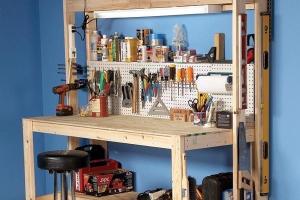Ultimate Guide to Building Your Own Garage Work Bench: Step-by-Step Instructions

-
Quick Links:
- Introduction
- Benefits of a Garage Work Bench
- Planning Your Work Bench
- Materials Needed
- Tools Required
- Step-by-Step Construction Guide
- Finishing Touches
- Maintaining Your Work Bench
- Case Studies
- FAQs
Introduction
Building a garage work bench can be a rewarding project that enhances your workspace and adds functionality to your garage. Whether you’re a seasoned DIYer or a beginner, our comprehensive guide will walk you through every step of the process.
Benefits of a Garage Work Bench
- Increased Workspace: A dedicated area for projects allows for more efficient work.
- Organization: Helps keep tools and materials organized.
- Customization: Tailor the bench to your specific needs and space.
- Cost-Effective: Building your own bench can save money compared to purchasing one.
Planning Your Work Bench
Before you start building, it’s essential to plan out your work bench. Consider these key elements:
- Size: Determine how much space you have available and how large your bench needs to be.
- Height: Choose a comfortable height that suits your work style.
- Style: Decide on a simple table design or a more complex workbench with storage.
Materials Needed
Here’s a list of materials you will need:
- 2x4 lumber for the frame
- 3/4 inch plywood for the top
- Wood screws
- Wood glue
- Sandpaper
- Finish (stain or paint)
Tools Required
To successfully build your garage work bench, you’ll need the following tools:
- Power drill
- Measuring tape
- Level
- Circular saw or miter saw
- Screwdriver
- Clamps
Step-by-Step Construction Guide
Step 1: Measure and Cut the Lumber
Start by measuring and cutting your 2x4 lumber to the desired lengths for the frame and legs.
Step 2: Assemble the Frame
Using wood screws and wood glue, assemble the frame of the workbench. Ensure it's square and level.
Step 3: Attach the Legs
Securely attach the legs to the frame, making sure they are sturdy and well-aligned.
Step 4: Add the Work Surface
Cut the plywood to size and secure it to the frame using screws.
Step 5: Sand and Finish
Sand the surfaces to ensure they are smooth, and apply your chosen finish for protection.
Finishing Touches
Consider adding features like tool racks, drawers, or a vise to enhance functionality.
Maintaining Your Work Bench
Regular maintenance includes cleaning the surface, checking for loose screws, and reapplying finish as needed.
Case Studies
Let’s explore a couple of real-world examples of successful garage work benches:
Case Study 1: The Family DIYer
This family built a versatile workbench that accommodates various projects, from woodworking to automotive repairs.
Case Study 2: The Professional Woodworker
A professional woodworker designed a robust bench that includes integrated storage and power outlets for tools.
FAQs
1. What is the ideal height for a garage work bench?
The ideal height is typically between 28 to 36 inches, depending on your height and the type of work you'll be doing.
2. How much weight can a workbench hold?
A well-built workbench can hold significantly more than its own weight, often exceeding 500 pounds.
3. What type of wood is best for a workbench?
Hardwood like maple or oak is preferred for durability, but softwoods like pine can also work for budget-friendly options.
4. Can I use reclaimed wood for my workbench?
Yes, reclaimed wood can be a great sustainable choice, but ensure it's sturdy and free of contaminants.
5. How do I prevent my workbench from wobbling?
Ensure that all legs are the same length and that the bench is placed on a level surface.
6. Should I add storage to my workbench?
Yes, incorporating storage like drawers or shelves can help keep your workspace organized.
7. How often should I maintain my workbench?
Inspect your workbench regularly for stability and clean it after each use to maintain its condition.
8. Is it necessary to sand my workbench?
Sanding is essential to remove splinters and create a smooth working surface.
9. What finish is best for a workbench?
A polyurethane finish is durable and provides excellent protection against spills and scratches.
10. Can I customize my workbench design?
Absolutely! Customizing your bench to fit your specific needs is one of the best parts of building it yourself.
For further reading on workbench designs and woodworking tips, check out these resources:
- Wood Magazine on Reclaimed Wood
- Family Handyman Workbench Guide
- Woodworker's Source on Building a Work Bench
Random Reads
- How to set up your nintendo wii
- How to open view dwg files
- How to open windows services
- Mastering the art of folding and storing your ironing board
- How to print a pdf document
- Netflix subscription free
- Naturally cleaning washing machine
- How to turn off firewall
- How to turn off javascript
- Identify motherboard type